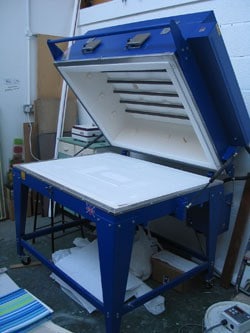I have a bunch of raw stained glass. I could never get the hang of soldering so I moved on and learned how to fuse glass. I hope to put my colored glass to use. Can I do melting tests for each of these pieces in my kiln in order to see if any can be fused? Is there a certain firing schedule or schedules you might recommend I try, if fusing with it is a possibility?
I do not plan to combine different sheets and do any layering. I fear they might not be compatible. I also don’t want to spend more time and money testing all of them to find out.
My intended projects include the following applications:
First, do a full fuse. Then do a slump on to a bisque mold.
First, do a full fuse. Then drape over a stainless steel vase mold.
I realize I will need to prep the fused glass molds.
Thanks for your advice! I love your site!by Cynthia Cook
Milly’s reply:
Hi Cynthia, thanks for your questions. There are two main ways of knowing if your glass is compatible – if it has been ‘Tested Compatible’ by the manufacturers (Bullseye, Spectrum 96 etc) or by doing your own compatibility testing.
If however, you’re not thinking of mixing the stained glass sheets, then you will have no problem with compatibility. It will obviously limit the effects you can achieve, as you will only be able to deepen or lighten the one colour, depending on how many layers you use.
I don’t know what stained glass sheets you have, but if they are from a wide range of manufacturers, I wouldn’t spend time compatibility testing them, it’s highly unlikely they will be ok. If however, they are the same manufacturer but different colours, you may want to give it a go. Here’s a fusing glass firing schedule which you can use for your projects:
Cut a strip of known base glass, and place small squares of the glass you want to test on top of it. Use a standard fusing schedule:
Ramp up at no more than 400F/222C ph to 968F/520C
AFAP to top temperature (depending on glass, between 1400F/760 and 1508F/820C
Soak up to 30 mins, depending on kiln and size of piece – I wouldn’t bother for the tests
AFAP to 900F/482C. Hold for 30 mins
Down 167F/75C ph to 698F/370C
Down 302F/150C ph to 392F/200C
Off
You’ll need two pieces of polarizing film which you can buy from stained glass art supplies outlets. Cross them to black out all the light, and then hold up to a strong light source – eg light table. If you can see halos of white light at the corners, you have stress and the stained glass sheets are not compatible.
Document EVERYTHING! You may need to ask the manufacturers what the fusing temperature of their glass is to get the correct top temperature.
Firing schedule for glass slumping process:
Ramp up at no more than 300F/167C ph to 1100F/600C
Soak for 10mins at 1100F/600C for even heating
Heat kiln slowly (100F/56C ph) until you reach correct slumping temperature for the glass slumping molds – between 1150F/620C for a simple mold to as high as 1300F/704C for more complex slumping molds.
Soak for about 30 mins.
Cool/anneal same as glass fusing firing schedule.
Hope this helps. Let me know how you get on.

